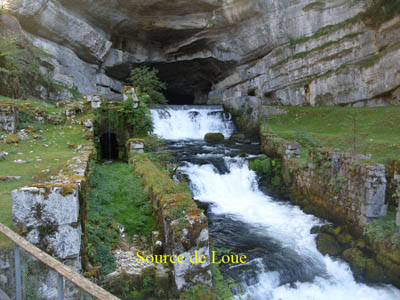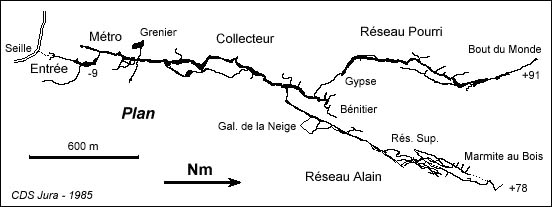

Summer Expedition to the Jura, France.
27th July – 10th August 2019
Lead contact: Gary Vaughan
Phone: 07836 727131 E-Mail: gary@dorsetland.co.uk
La Borne Aux Cassots
Length 15000m, VR -144m, Time 12-20 hours
GPS UTM 31T-0701870-5179250 305m
Borne aux Cassots is one of the few caves in the Jura that requires prior permission. The entrance is gated and access is controlled on behalf of the commune of Nevy-sur-Seille by le Comité Départemental de Spéléologie du Jura, who will supply the combination to members of F.F.S or a recognised foreign organisation e.g. BCRA on confirmation of a favourable weather forecast. Although much of the cave is dry, the entrance series floods frequently, and several teams have had to be rescued by divers. A request for access can be made to :- Eric DAVID - Montadroit 39240 LEGNA Tél : 03 84 35 74 47 (weekend) or 04 78 74 37 61 (weekdays)
Take the D204 from Nevy-sur-Seille towards Baume-les-Messieurs. At the first crossroads, turn left towards Ladoye-sur-Seille and follow for 500m to where the road crosses a small bridge over an intermittent stream. A widening in the road just beyond is the car park. The cave entrance lies a few tens of metres above the bridge, on the right-hand side of the stream. Note - Progress can be exceedingly warm, so lightweight kit is advised.
Entrance Series
The first 150m of the entrance series is a masterpiece of French engineering,
where high and wide dry-stone walling complete with paved steps lead to
a labyrinth. This marks the low, flood-prone point of the cave. Beyond
the labyrinth, a strongly-draughting tube ascends to emerge in a much
larger passage, The Metro. Left chokes after 100m, but right leads for
150m to the main streamway – the Collecteur.
The Collecteur
This is followed in 10m x 10m passage for 250m to a sump. Part way along
the streamway, a 4m climb up an stalagmite boss leads to a rift. Right
can be followed for 150m to a boulder choke. Left leads for 100m to a
huge (60m x 30m), blind chamber. Above the sump, a vast fossil gallery
(20m x 15m) is followed over boulder and scree mountains. The walls are
decorated with Gypsum flowers and the route passes beneath several fine
phreatic domes, in one of which, at about 5m height, a fossil tree trunk
dated to 180 million years, can be seen. After 700m, a 20m shaft back
down to the streamway is bypassed, 50m beyond which a balcony is reached.
Climb down 6m over blocks on the left (handline useful) and cross to the
right-hand bank to regain the main streamway. This is followed upstream
for 200m in a beautiful 20m x 30m gallery to The Confluence, a major junction.
Left leads to Réseau Pourri. Right leads to Réseau Alain.
Reseau Pourri
Turning left, enters Galerie du Bénitier, a vast semi-fossil gallery,
similar in form to the Collecteur, which ends in a boulder choke after
300m. 150m along this passage, a narrow passage on the left gives access
to Galerie du Gypse, reached by 100m of calcite crawls and ramps. This
emerges in a larger, crumbling gallery of 10 x 5m, which can be followed
for 700m until it diminishes. This is the End of the World Series, where
a further 450m terminate in a series of chimneys and choked upper galleries.
Reseau Alain
Turning right at the Confluence enters Reseau Alain, the continuation
of the main streamway. Crossing to the right bank, upstream progress is
made almost permanently along the sandy bed of the stream. After 200m,
a series of narrow bends is bypassed on the right by following the Gallery
of Snow, a fossil conduit whose walls are covered with gypsum dust. A
few hundred metres beyond, the streamway eminates from an insuperable
choke. The water has been traced from a point 6 km beyond !!. Above the
choke, a roof level passage on the right, leads to the Upper Network,
a labyrinth of very well decorated passages, one of which terminates in
a 20m deep pitch back to the streamway, 350m downstream of the choke.
150m downstream from the choke, an inlet on the left leads to Galerie
de la Marmite au Bois, which contains another fossil wood fragment, concealed
in calcite in a pot in the floor.
Updated 01.11.18
